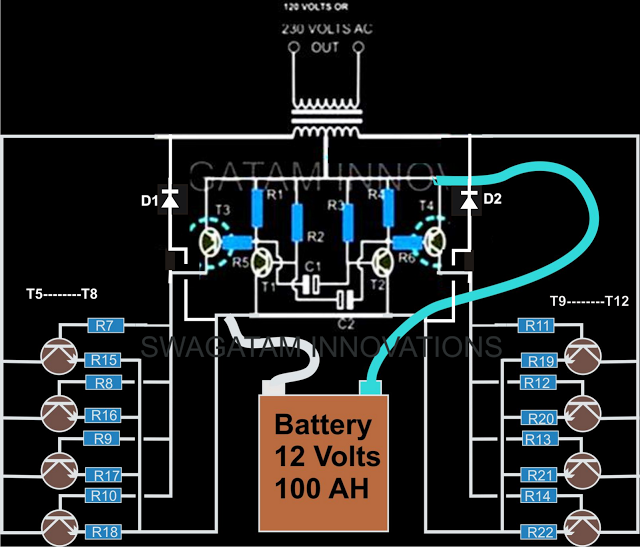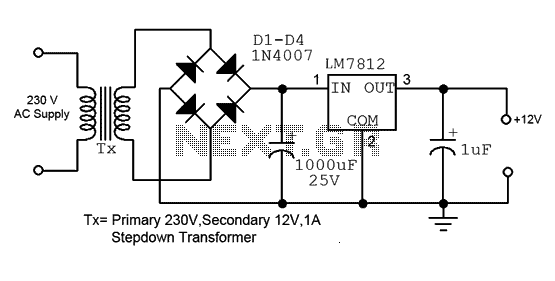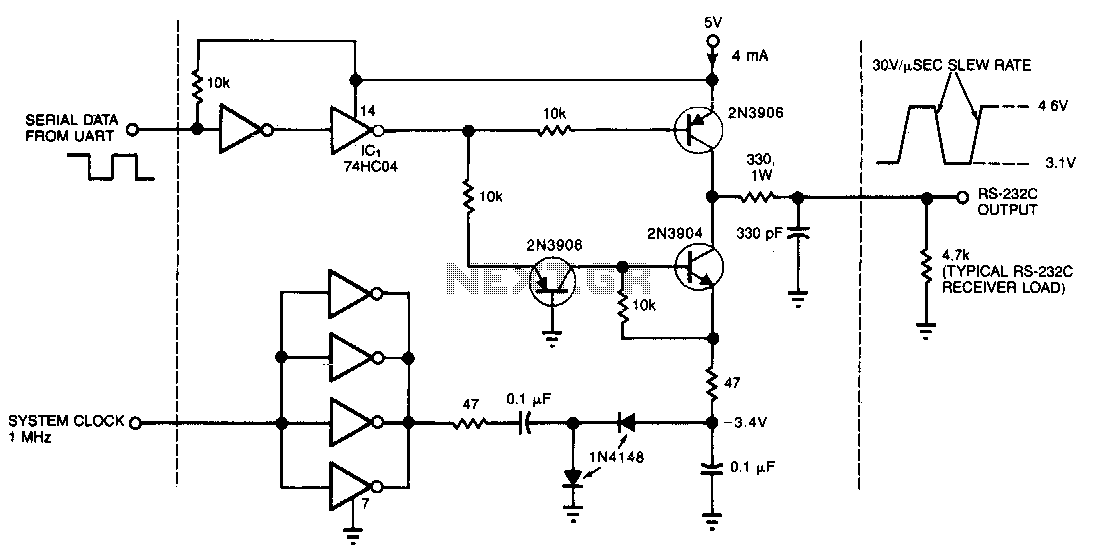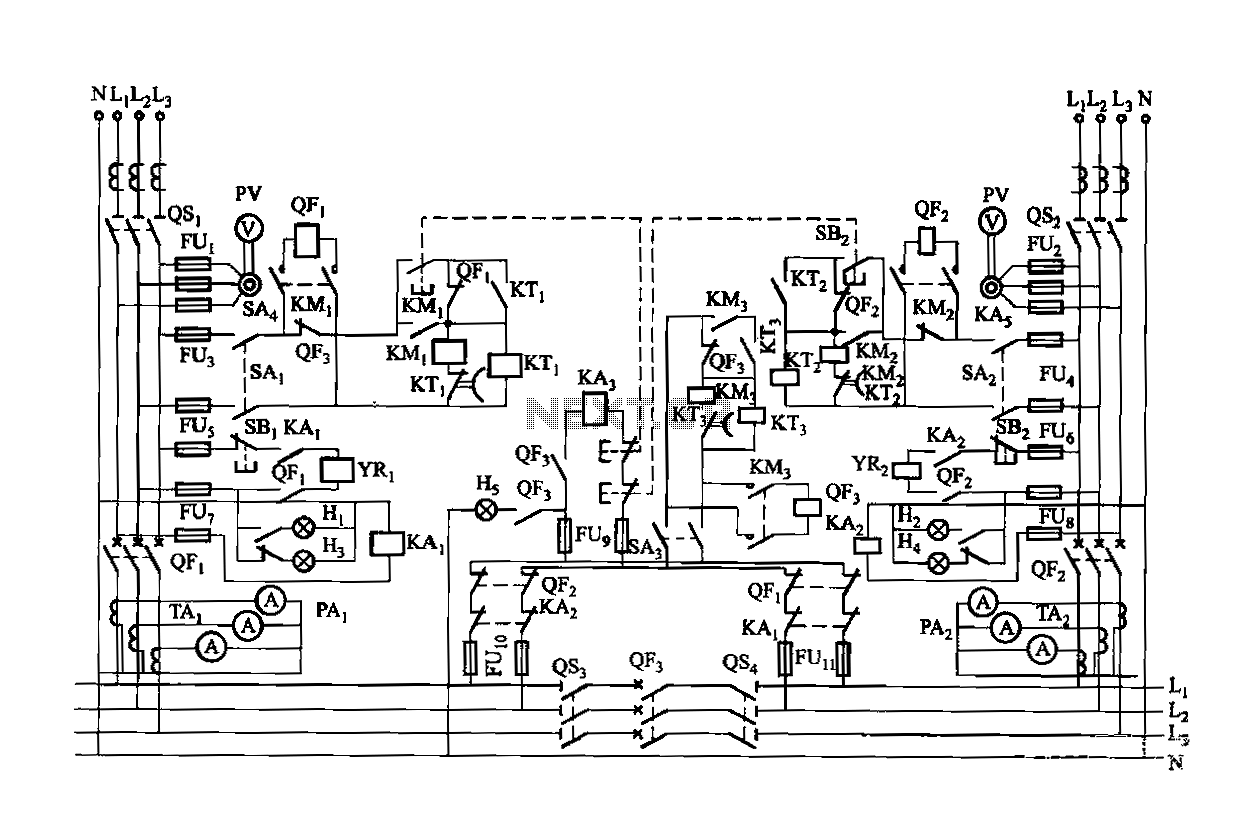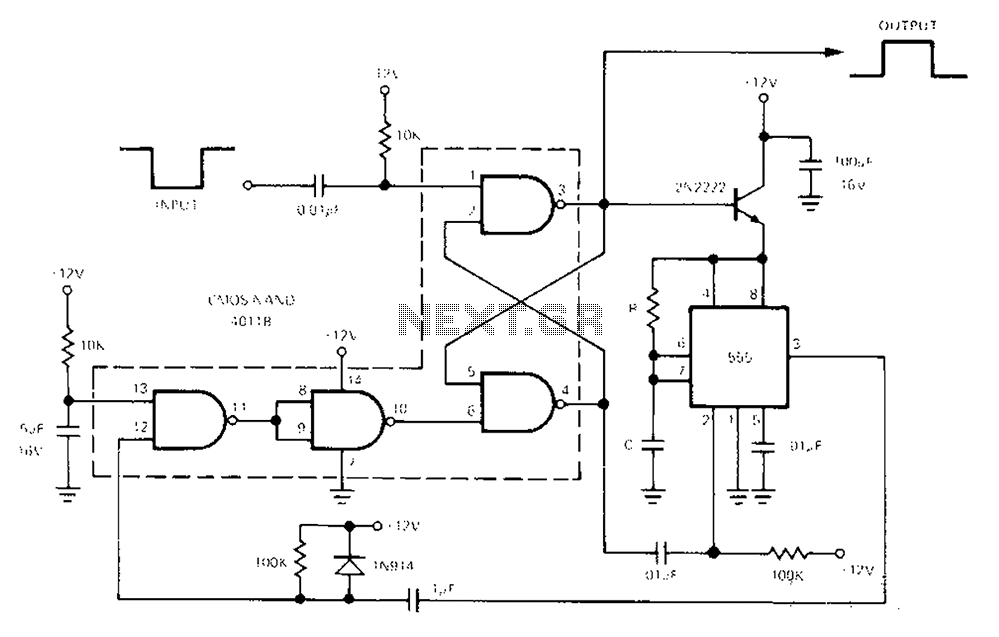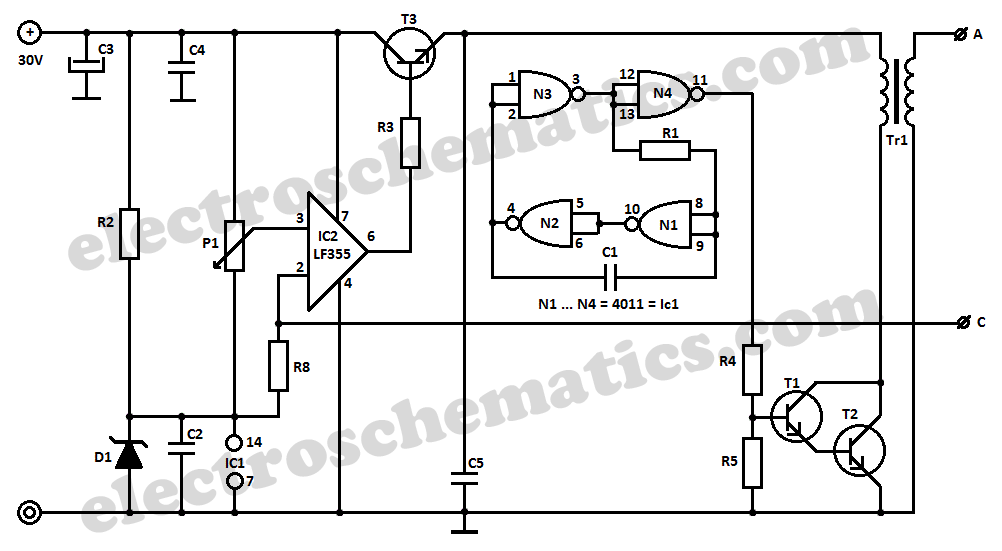
12V 10Amp MJ2955 Switching Power Supply
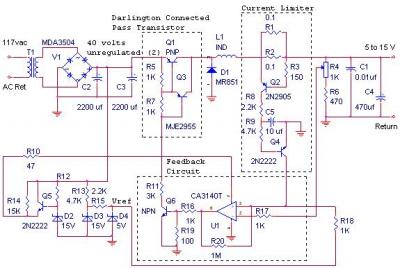
The switching power supply delivers 12 volts at a maximum current of 10 amps, utilizing a discrete transistor regulator with an operational amplifier functioning as a comparator within the feedback loop. The schematic does not depict the front panel power-on indicator. Although there is no adjustable current limiter in this unit, resistors R1, R2, R3, along with transistors Q2, Q4, and resistors R8, R9, and capacitor C5, are configured to set the current limit at approximately 10 amps. The design bears a close resemblance to that of a linear power supply, with the addition of inductor L1 and diode D1, while U1 operates in a switching mode as a comparator featuring a slight amount of hysteresis. The switching frequency of this unit fluctuates based on the output current drawn by the load, which is an undesirable characteristic, leading to the preference for PWM regulators in contemporary designs. PWM regulators maintain a constant switching frequency, resulting in spurious signals only at known discrete frequencies rather than across a broad spectrum. The schematic includes a Darlington-connected pass transistor block arranged in parallel for enhanced robustness. Resistor R4 acts as an internal trim-pot, allowing the output voltage to be adjusted anywhere between 5 to 15 volts.
The switching power supply circuit is designed to efficiently convert electrical energy while maintaining a stable output voltage of 12 volts. The core of the design revolves around a discrete transistor regulator, which is complemented by an operational amplifier that serves as a comparator. This configuration ensures that the output voltage is regulated effectively, responding to variations in load conditions.
The absence of an adjustable current limiter is noteworthy; however, the components R1, R2, R3, Q2, R4, R8, R9, C5, and Q4 collectively establish a current limiting mechanism that caps the output at approximately 10 amps. This feature is critical for protecting both the power supply and connected loads from overcurrent conditions.
The inclusion of inductor L1 and diode D1 differentiates this switching power supply from traditional linear designs. L1 serves to smooth out the output current, while D1 provides a path for the inductor current when the switch is turned off, contributing to the overall efficiency of the circuit. The operational amplifier (U1) operates as a comparator, utilizing a small amount of hysteresis to stabilize the feedback loop, thereby enhancing the transient response of the power supply.
A significant aspect of this design is the variable switching frequency that correlates with the output load current. While this feature may introduce unwanted noise and spurious signals, it is a common characteristic in simpler switching power supplies. In contrast, modern designs often employ PWM (Pulse Width Modulation) techniques to maintain a constant switching frequency, which minimizes electromagnetic interference and enhances performance.
The use of a Darlington pair configuration for the pass transistors increases the current handling capability and ensures robustness in the design. This configuration allows for higher gain, which is beneficial in maintaining stable operation under varying load conditions. The internal trim-pot (R4) provides versatility, enabling the adjustment of the output voltage within a range of 5 to 15 volts, accommodating various application requirements.
In summary, this switching power supply design effectively combines traditional linear power supply principles with modern switching techniques, providing a reliable and adjustable voltage source suitable for a variety of electronic applications.The switching power supply provides 12 volts, at 10 amps, maximum, using a discrete transistor regulator with an op-amp functioning as a comparator in the feedback circuit. With reference to the schematic, the front panel power-on light is not shown. There is no adjustable current limiter in this unit, although R1, R2, R3, Q2, R8, R9, C5 and Q4 se t the current limit to approximately 10 amps. As you can see, the design is very similar to that of a linear power supply, except that L1, and D1 have been added, and U1 operates in a switching mode as a comparator with a small amount of hystersis. The switching frequency of this unit varies with the output current drawn by the load. This is an undesireable feature, which is why PWM regulators are used today. With a PWM regulator, the switching frequency is constant and will produce spurs only at known discrete frequencies rather than spurs at all frequencies.
The Darlington-connected pass transistor block in the schematic is there twice (in parallel) for robustness. R4 in an internal trim-pot that can set the output voltage anywhere between 5 to 15 volts. 🔗 External reference
The switching power supply circuit is designed to efficiently convert electrical energy while maintaining a stable output voltage of 12 volts. The core of the design revolves around a discrete transistor regulator, which is complemented by an operational amplifier that serves as a comparator. This configuration ensures that the output voltage is regulated effectively, responding to variations in load conditions.
The absence of an adjustable current limiter is noteworthy; however, the components R1, R2, R3, Q2, R4, R8, R9, C5, and Q4 collectively establish a current limiting mechanism that caps the output at approximately 10 amps. This feature is critical for protecting both the power supply and connected loads from overcurrent conditions.
The inclusion of inductor L1 and diode D1 differentiates this switching power supply from traditional linear designs. L1 serves to smooth out the output current, while D1 provides a path for the inductor current when the switch is turned off, contributing to the overall efficiency of the circuit. The operational amplifier (U1) operates as a comparator, utilizing a small amount of hysteresis to stabilize the feedback loop, thereby enhancing the transient response of the power supply.
A significant aspect of this design is the variable switching frequency that correlates with the output load current. While this feature may introduce unwanted noise and spurious signals, it is a common characteristic in simpler switching power supplies. In contrast, modern designs often employ PWM (Pulse Width Modulation) techniques to maintain a constant switching frequency, which minimizes electromagnetic interference and enhances performance.
The use of a Darlington pair configuration for the pass transistors increases the current handling capability and ensures robustness in the design. This configuration allows for higher gain, which is beneficial in maintaining stable operation under varying load conditions. The internal trim-pot (R4) provides versatility, enabling the adjustment of the output voltage within a range of 5 to 15 volts, accommodating various application requirements.
In summary, this switching power supply design effectively combines traditional linear power supply principles with modern switching techniques, providing a reliable and adjustable voltage source suitable for a variety of electronic applications.The switching power supply provides 12 volts, at 10 amps, maximum, using a discrete transistor regulator with an op-amp functioning as a comparator in the feedback circuit. With reference to the schematic, the front panel power-on light is not shown. There is no adjustable current limiter in this unit, although R1, R2, R3, Q2, R8, R9, C5 and Q4 se t the current limit to approximately 10 amps. As you can see, the design is very similar to that of a linear power supply, except that L1, and D1 have been added, and U1 operates in a switching mode as a comparator with a small amount of hystersis. The switching frequency of this unit varies with the output current drawn by the load. This is an undesireable feature, which is why PWM regulators are used today. With a PWM regulator, the switching frequency is constant and will produce spurs only at known discrete frequencies rather than spurs at all frequencies.
The Darlington-connected pass transistor block in the schematic is there twice (in parallel) for robustness. R4 in an internal trim-pot that can set the output voltage anywhere between 5 to 15 volts. 🔗 External reference
